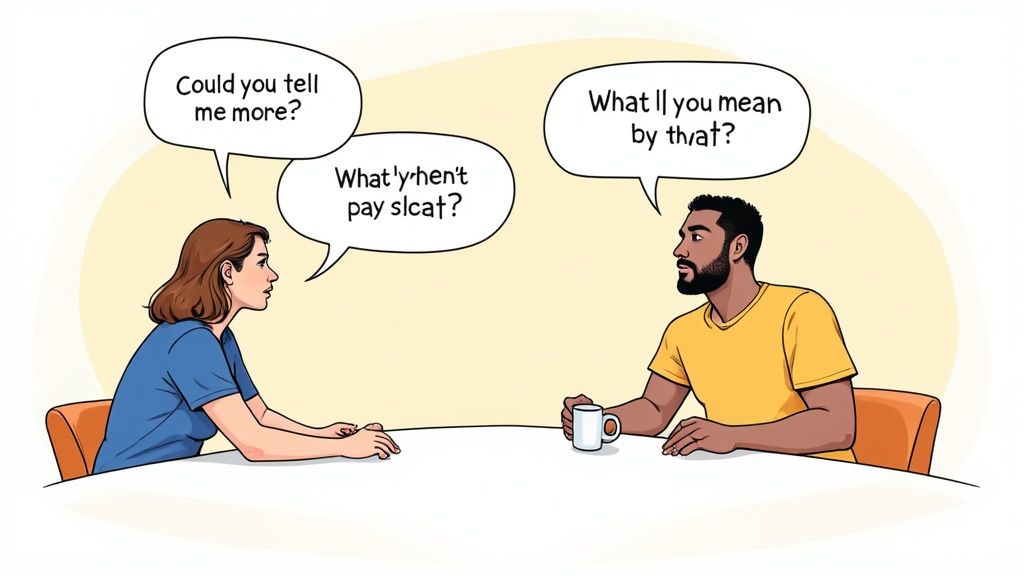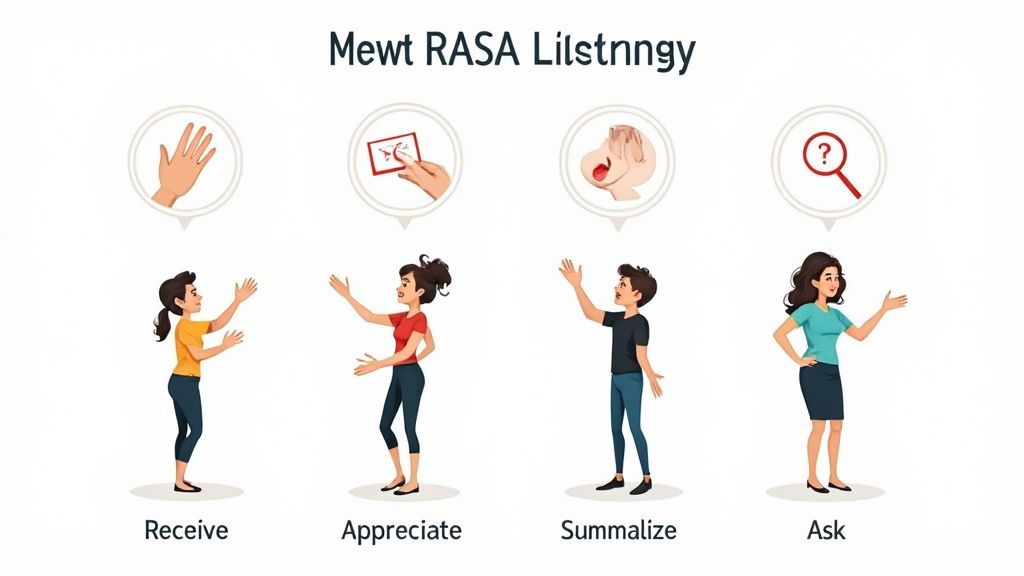10 Active Listening Techniques to Improve Communication


Unlock the Power of Truly Hearing Others
Most of us face constant streams of information, yet deep connections feel rare and hard to come by. Authentic understanding comes from more than just catching words - it takes focused attention and real engagement. Research shows that 73% of listeners get distracted, worried, or overwhelmed during conversations. Professional coaches and counselors have long recognized that active listening is essential for building trust and rapport.
Good listening involves several key elements:
- Being fully present and engaged
- Picking up on nonverbal cues and emotions
- Reflecting back what you hear to confirm understanding
- Asking thoughtful follow-up questions
- Avoiding judgment or interruption
When we develop these listening skills, the benefits ripple through every area of life. Research demonstrates that active listening leads to:
- Stronger personal relationships
- Better workplace collaboration
- More effective leadership
- Reduced conflict and misunderstandings
- Increased empathy and emotional intelligence
Ready to strengthen your listening abilities and create deeper connections? Let's explore 10 proven techniques that can help you become a more attentive, understanding listener and build more meaningful relationships across all areas of your life.
1. SOLER Technique: Nonverbal Communication for Effective Listening
Active listening goes beyond just hearing words - it requires full engagement with the speaker to help them feel understood. The SOLER technique, developed by Gerard Egan in counseling psychology, provides a clear framework for nonverbal communication that builds connection and rapport through intentional physical positioning.

The SOLER acronym outlines five key elements:
- Squarely facing the speaker: Position your body directly toward them to show you're giving your full attention
- Open posture: Keep arms and legs uncrossed to appear approachable and receptive
- Leaning slightly forward: A gentle lean shows you're engaged and interested
- Eye contact: Maintain appropriate eye contact while being culturally sensitive
- Relaxed body language: Stay calm and still, avoiding distracting movements
Building Connection Through SOLER:
This technique helps create genuine connection by validating the speaker. Consider a coaching session about a career change - when the coach uses SOLER positioning, maintains an open stance, leans in attentively, makes good eye contact, and stays relaxed, the client feels more comfortable opening up about their challenges.
Practical Applications:
SOLER works well in many settings:
- Performance reviews: Creates a supportive environment for giving and receiving feedback
- Mediating disputes: Shows willingness to understand different viewpoints
- Client meetings: Builds trust and rapport to facilitate productive discussions
Key Benefits and Limitations:
Benefits:
- Quick rapport building
- Makes people feel heard
- Adaptable across cultures
Limitations:
- Can seem forced if not practiced
- Cultural eye contact norms vary
- More challenging in video calls
Implementation Tips:
- Master one element at a time: Start with open posture, then add other components
- Consider cultural context: Adjust eye contact based on cultural norms
- Stay natural: Avoid rigid or mechanical movements
- Adapt for virtual meetings: Focus on camera eye contact and visible posture
When applied thoughtfully, SOLER helps create meaningful connections through intentional nonverbal communication. While it takes practice to feel natural, the technique's ability to create a supportive environment makes it valuable for effective communication.
2. Paraphrasing
Paraphrasing lets you reflect back what someone says using your own words while keeping the core meaning intact. Rather than just repeating their exact words, you demonstrate that you truly understand the message. This fundamental active listening skill helps create stronger connections, improve understanding, and prevent misunderstandings.
Why Paraphrasing Matters
When used effectively, paraphrasing provides several key benefits for coaches and those focused on personal growth:
- Shows Real Understanding: By processing and restating the message in your own words, you demonstrate that you're truly engaged and listening, not just hearing the words.
- Makes Others Feel Heard: When people hear their thoughts and feelings reflected back accurately, they feel understood and validated. This creates an environment where open sharing feels safe.
- Prevents Confusion: By checking your understanding through paraphrasing, you can catch and fix any misunderstandings early before they cause problems.
Real-World Applications & Case Studies
Picture a coaching session where a client says they're drowning in work. Instead of jumping to advice, an effective coach might say: "It sounds like you're feeling overwhelmed by all your tasks and finding it hard to stay on top of everything?" This gives the client a chance to confirm or clarify their meaning.
Or consider a team meeting where someone raises concerns about project timing. A helpful paraphrase could be: "Let me make sure I understand - you're worried we won't have enough testing time before launch with the current schedule?" This opens up productive discussion around the specific concern.
While we can't pinpoint exactly when paraphrasing emerged as a communication technique, it gained prominence alongside the growth of counseling and therapy fields. These disciplines highlighted how critical understanding and empathy are for effective communication.
Pros & Cons of Paraphrasing:
Pros:
- Creates deeper understanding and trust
- Helps avoid miscommunication
- Shows you value what others say
Cons:
- Can disrupt conversation flow if overused
- May feel unnecessary in some situations
- Takes practice to do naturally
Practical Tips for Implementation:
- Choose different words: Show you processed the message rather than just repeating it
- Keep it brief: Focus on the main points without getting lost in details
- Acknowledge feelings: "You seem frustrated with how this is going" captures both facts and emotions
- Use confirming phrases: Start with "If I'm hearing you correctly..." or "Let me make sure I understand..."
Example:
- Speaker: "I can't handle this project anymore. The timeline is impossible and I don't have what I need to get it done."
- Listener: "It sounds like you're feeling overwhelmed because you don't have enough time or resources to complete this project properly. Is that right?"
By making paraphrasing a regular part of how you listen and respond, you can build stronger relationships and communicate more effectively. This skill serves anyone looking to better understand and connect with others.
3. Mirroring
Mirroring refers to subtle reflections of someone's body language, tone, and energy level when listening. This powerful technique helps build authentic connections and psychological safety. Rather than obvious mimicking, effective mirroring creates natural rapport through small, synchronized shifts in how we engage with others.

Key elements of mirroring include:
- Voice and Speech: Match the speaker's volume, pace and tone naturally. If they speak softly and deliberately, gradually adjust your voice to align.
- Physical Expression: Reflect posture, gestures and facial expressions subtly. If they lean in while speaking, you might do the same after a brief delay.
- Energy and Mood: Align with their emotional state and energy level authentically. Match their enthusiasm or calmness to help them feel understood.
Background and Development:
This technique gained prominence through the work of NLP creators Richard Bandler and John Grinder, along with psychologist Carl Rogers' client-centered therapy approach. These experts showed how subtle mirroring builds trust and enables deeper communication.
Practical Application:
Consider a coaching session where a client shares their frustration about a challenge. By naturally reflecting their concerned expression and tone, the coach creates an unspoken bond of understanding. Research shows that when people feel truly heard, they become more open to guidance and insights.
Benefits:
- Natural Trust Building: Taps into our innate drive to connect with others who understand us
- Enhanced Comfort: Creates psychological safety for open expression
- Stronger Relationships: Forms the foundation for meaningful connections
Challenges:
- Risk of Appearing Insincere: Obvious or exaggerated mirroring can seem manipulative
- Learning Curve: Requires practice to implement naturally
- Context Awareness: Not suitable in all situations, especially with power imbalances
Tips for Success:
- Stay Subtle: Focus on general demeanor rather than copying specific movements
- Allow Delay: Wait a few moments before reflecting changes in expression or tone
- Match Energy Level: Prioritize aligning with their overall emotional state
- Build Gradually: Practice in low-pressure situations to develop natural skill
When applied thoughtfully, mirroring helps create authentic connections and enables more meaningful conversations. With practice, it becomes a valuable tool for better understanding and supporting others.
4. Clarifying Questions

At the heart of active listening lies the skill of asking good questions. When you ask specific questions to better understand someone's meaning, you move beyond simply hearing words to truly grasping their perspective. This simple yet powerful technique helps build real connections and mutual understanding.
Key Benefits:
- Deeper conversations: Questions invite people to share more fully
- Better understanding: Help speakers explore their own thoughts more deeply
- Trust building: Show you genuinely care about understanding their view
Advantages:
- Clear communication: Questions help prevent misunderstandings between people
- Full engagement: Shows you're mentally present and processing what's being said
- Root cause discovery: Often reveals the real issues beneath surface statements
Potential Challenges:
- Risk of overuse: Too many questions can feel like an interrogation
- Tone matters: Questions need to be asked sensitively and appropriately
- Wording is key: Poor phrasing can create confusion or defensiveness
Sample Questions:
- "Would you expand on that point?"
- "What specifically do you mean by...?"
- "How did that affect you?"
- "What were your thoughts at the time?"
- "Could you share an example?"
Best Practices:
- Ask open questions: Start with "what," "how," and "could" to encourage detailed responses
- Skip "why" questions: These can seem judgmental - rephrase to be more inviting
- Time questions well: Wait for natural pauses rather than interrupting
- Watch body language: Notice if someone seems uncomfortable and adjust accordingly
Real Example:
In a coaching session, if someone says "I'm feeling stuck," asking "What areas of your work feel most challenging right now?" opens up productive dialogue. Compare this to "Why can't you figure it out?" which could make them defensive and shut down sharing.
Historical Context:
While questioning techniques trace back to ancient philosophical traditions, their specific application in active listening has grown with the emergence of coaching and counseling fields. The focus on empathy and understanding in these professions has shown how well-crafted questions can create breakthrough moments.
By developing strong questioning skills, you can create an environment where people feel heard and understood. Rather than just collecting information, good questions help build authentic connections and guide others toward valuable insights about themselves.
5. Emotional Labeling
Emotional labeling is a key active listening technique that involves recognizing and naming the emotions behind what someone is saying. It goes beyond just hearing words to understanding how the speaker feels. This skill helps build trust and enables deeper communication.
When you label emotions, you validate the speaker's feelings and make the emotional content of their message explicit. This creates awareness for both parties and helps people process their emotional experiences more effectively.
Key Aspects of Emotional Labeling:
- Emotional Focus: Look beyond surface-level content to understand underlying feelings
- Validation: Accept emotions as valid experiences, regardless of your own perspective
- Increased Awareness: Make emotions clear and manageable by naming them directly
Benefits:
- Stronger Connections: People feel truly understood when their emotions are acknowledged
- Better Emotional Skills: Shows ability to perceive and understand others' feelings
- Supports Processing: Naming emotions helps speakers better understand their experiences
Potential Challenges:
- Accuracy is Critical: Misidentifying emotions can damage rapport
- Comfort Level Varies: Some find emotional discussions uncomfortable
- Requires Practice: Developing emotional awareness takes time and effort
Example Phrases:
- "It sounds like you're feeling overwhelmed."
- "I sense this is frustrating for you."
- "It seems like you're feeling quite anxious about this."
Best Practices:
- Use Soft Language: Start with "It seems..." or "I sense..." to allow for corrections
- Watch Body Language: Notice facial expressions, tone, and posture for emotional cues
- Welcome Feedback: Be ready to adjust your understanding based on the speaker's response
History and Development:
This technique gained attention through FBI negotiation tactics, as highlighted by Chris Voss. It proved vital for understanding emotions in high-stakes situations. The approach has since spread to coaching, counseling, and conflict resolution.
Real Example:
Consider a coaching session where a client discusses missing a promotion. Rather than jumping to solutions, the coach might say: "It seems like you're feeling disappointed and perhaps even a little betrayed by this outcome." This creates space for exploring those feelings.
The Value of Emotional Labeling:
This technique matters because it shows real effort to understand someone's emotional experience. By connecting at this deeper level, you build trust and help others process complex feelings. For coaches and those interested in personal growth, emotional labeling becomes an essential tool for supporting development and self-awareness.
6. Summarizing
When active listening, summarizing helps capture and restate the key points of a conversation. It shows you're paying close attention and helps build shared understanding between people. This makes it particularly valuable for coaches and anyone focused on personal development.
Key Benefits of Summarizing:
- Captures Main Ideas: Helps break down complex information into clear, memorable points
- Creates Structure: Highlights major themes and keeps discussions organized and focused
- Confirms Understanding: Allows both people to check their understanding and fix any misunderstandings early
Real Examples in Action:
In a coaching session, a client might share various career goals and concerns. A coach could summarize: "If I understand correctly, you're weighing pursuing leadership roles against work-life balance. You see great potential in leadership but worry about the time commitment." This gives the client a chance to confirm or clarify their thoughts.
During business negotiations, summarizing prevents costly mix-ups. After discussing terms, someone might say "Let me confirm - we've agreed on X price, delivery by Y date, and Z payment terms." This ensures everyone has the same understanding.
Growth and Development:
While people have always used summarizing naturally in conversations, it's become more recognized as a specific technique with the growth of coaching, counseling and conflict resolution. These fields highlight how summarizing builds understanding and helps achieve better outcomes.
Benefits and Challenges:
Benefits:
- Makes complex information clearer
- Shows active engagement
- Catches misunderstandings early
Challenges:
- Can feel unnatural in casual talks
- Takes practice to do well
- Timing is important
Practical Tips:
- Find Natural Moments: Summarize after key points or before new topics
- Focus on Main Ideas: Identify core messages without getting lost in details
- Keep it Simple: Use clear, straightforward language
- Check Understanding: Use phrases like "Let me make sure I've got this right..."
Why Summarizing Matters:
Summarizing bridges the gap between hearing words and truly understanding meaning. It creates clarity, ensures accuracy, and shows respect for the speaker's message. For coaches and those in personal development, it's essential for having meaningful conversations that help people reach their goals.
7. Silent Listening
Silent listening is a method that focuses on fully absorbing what someone is saying without verbal interruption. The listener stays engaged through body language like nodding, eye contact, and open posture, creating space for the speaker to share openly. The emphasis is on being fully present rather than planning your next response.
Key Elements of Silent Listening:
- Limited verbal responses: Using minimal words and letting nonverbal cues do the communicating. Brief responses like "Mmm-hmm" are fine, but the speaker leads the conversation.
- Active nonverbal signals: Maintaining eye contact, leaning in slightly, and showing engagement through facial expressions lets the speaker know they're being heard.
- Patient space: Giving the speaker time to gather thoughts and express themselves fully, even during quiet moments.
Why This Technique Matters:
For coaches and mentors, understanding others deeply is essential. Silent listening helps build real connections and meaningful dialogue. When given uninterrupted space, speakers often reach new insights they wouldn't have discovered otherwise. This makes it valuable for anyone wanting to improve how they communicate.
Benefits:
- Complete expression: Speakers can fully share their thoughts without getting cut off, leading to better self-understanding.
- No disruptions: The speaker's train of thought stays intact when they aren't interrupted.
- Helpful in sensitive moments: Creates a supportive environment for sharing vulnerable feelings.
Challenges:
- Can feel strange: People used to constant back-and-forth may find the quiet uncomfortable.
- Possible misunderstanding: Without proper nonverbal signals, silence might seem like lack of interest.
- Requires comfort with quiet: Both parties need to be okay with pauses in conversation.
Real Examples:
Take a career coaching session where a client feels stuck about their next move. By using silent listening, the coach allows them to voice all their worries and options without jumping in. This helps the client work through their thoughts and reach their own answers.
Person-centered therapy, developed by Carl Rogers, relies heavily on silent listening. Rogers found that giving clients a judgment-free space to express themselves led to personal growth. Research supports this approach's success in therapy.
Tips for Practice:
- Use subtle encouragement: Small nods and brief sounds show you're listening without taking over.
- Keep engaged body language: Show attention through open posture, eye contact, and leaning forward slightly.
- Get comfortable with quiet: Practice having silent moments in daily life to build comfort with pauses.
By developing silent listening skills, coaches and personal development professionals can build stronger connections and help others reach deeper understanding.
8. RASA Technique
Active listening means understanding the speaker's complete message and making them feel understood. The RASA technique, created by sound expert Julian Treasure, offers a clear framework for better listening.

This approach stands out because it combines key listening skills into an easy-to-remember format. The acronym RASA (Receive, Appreciate, Summarize, Ask) provides clear steps to help you connect more deeply with speakers.
Here's how each step works:
Receive: Give your full attention to the speaker. Make eye contact, put away distractions, and notice their words, body language, and tone. Create an environment where they feel heard.
Appreciate: Show you're listening through small gestures like nodding, saying "I see," or brief words of understanding. These simple responses let the speaker know you're engaged.
Summarize: Briefly restate the main points to check your understanding. You might say "Let me make sure I understand - you're saying..." This helps clear up any confusion.
Ask: Use questions to get more details and show interest. Open-ended questions work best. Instead of "Did that make you upset?" try "How did that situation affect you?"
Real Example: Picture a coaching session where a client discusses a recent challenge. The coach would first receive by focusing completely on the client's words and expressions. They'd appreciate by nodding and offering brief supportive responses. Then they'd summarize: "I hear that you're feeling frustrated about missing your target this month." Finally, they'd ask: "What do you think were the main factors that affected the outcome?"
Background: Julian Treasure shared the RASA technique through his popular TED Talks about listening. He noticed that careful listening is becoming rare, and RASA offers practical steps to improve communication.
Benefits:
- Simple structure for better listening
- Easy to remember and use
- Covers all important listening elements
Challenges:
- May seem mechanical at first
- Takes time to master
- Not every step fits every situation
Tips for Using RASA:
- Start with one step: Master each part of RASA before combining them
- Be flexible: Adjust the order based on each conversation
- Keep it natural: Work the steps into your style smoothly
By practicing RASA, coaches and personal growth enthusiasts can improve their communication skills and build stronger connections with others.
9. Empathetic Response
Active listening goes beyond simply hearing words - it requires truly understanding the speaker's emotions and perspective. Empathetic responding means showing genuine comprehension of someone's situation through both verbal and non-verbal communication. This core skill helps create trust and enables meaningful dialogue.
Key Elements of Empathetic Responses:
- Emotional Recognition: Accurately identify and acknowledge emotions, even when not directly stated
- Experience Validation: Affirm that the speaker's feelings are valid, regardless of personal agreement
- Safe Environment: Create conditions where people feel comfortable sharing vulnerable thoughts
The Value in Personal Development:
Empathetic responses play a vital role in coaching and personal growth. By helping people feel truly heard and understood, this approach builds the trust needed for honest self-exploration. When individuals know their experiences are being respected, they become more open to guidance and feedback.
Benefits:
- Deeper Relationships: Mutual understanding creates meaningful connections
- Increased Disclosure: People share more openly when they feel safe
- Growth Environment: Allows for the vulnerability needed for personal development
Potential Challenges:
- Emotional Cost: Supporting others' feelings can be draining, especially for sensitive people
- Skill Requirements: Needs strong emotional intelligence to interpret feelings accurately
- Workplace Fit: Some professional settings may favor objectivity over emotional engagement
Real Application Examples:
- Career Coaching: When a client expresses career frustration, responding with "That sounds really disappointing after all your hard work"
- Group Workshop: Supporting a participant sharing insecurities by saying "Thank you for your honesty - many people struggle with similar feelings"
- Research Finding: Studies show therapy clients make more progress when working with empathetic counselors
Historical Context:
While empathy is innate to humans, its formal recognition as a communication tool grew through humanistic psychology. The work of Carl Rogers highlighted empathy's role in personal growth, leading to wider adoption in helping professions.
Implementation Guidelines:
- Stay Authentic: Use natural responses rather than scripts
- Keep Focus on Others: Avoid shifting to your own experiences
- See Their View: Try understanding their perspective, even if different from yours
- Show Attention: Maintain eye contact, nod, and use open body language
Sample Empathetic Phrases:
- "That must be really challenging"
- "I understand why you'd feel that way"
- "It sounds like you're dealing with a lot"
- "I hear how frustrated you are"
By mastering empathetic responses, you can develop stronger connections and support others more effectively in their personal growth journey.
10. Note-Taking
Note-taking is a powerful active listening method where you record key points during conversations to better understand and retain information. Done well, it shows genuine interest in what others are saying while creating a valuable record for later reference.
The goal isn't to write down every word - instead, capture the main ideas and important details. By noting key concepts, questions, and action items, you build a reliable record that demonstrates your commitment to understanding the speaker's message.
Key Benefits:
- Creates a Reliable Record: Notes give you concrete details to reference later, which is especially helpful for complex topics or when you need to recall specifics
- Shows Active Engagement: Taking notes signals to the speaker that you're fully present and invested in understanding them
- Improves Memory and Follow-up: Reading through notes after a conversation helps cement the information and enables you to address specific points later
Advantages:
- Better Information Retention: Research shows that taking notes, even without reviewing them, helps people remember more
- Shows You Care: The visible act of note-taking demonstrates attention and respect
- Handles Complex Topics: Notes help process and organize complicated information
Drawbacks:
- Can Distract: Note-taking may pull focus from the speaker if not done carefully
- Less Eye Contact: Looking down to write means less direct engagement
- Not Always Appropriate: Some casual or personal conversations aren't suited for note-taking
Real-World Applications:
- Meeting Minutes: Formal documentation of decisions, assignments, and key discussion points
- Counseling Records: Mental health professionals track client progress and recurring themes
- Interview Documentation: Hiring managers record candidate responses to compare applicants
Growth and Adoption:
Note-taking has existed for centuries, but its role in active listening grew significantly with the expansion of personal development and coaching fields. As communication skills became more valued, note-taking emerged as an important tool for showing understanding and follow-through.
Practical Guidelines:
- Ask First: In informal settings, check if the speaker is comfortable with you taking notes
- Focus on Key Points: Record essential ideas and keywords rather than trying to capture everything
- Keep Eye Contact: Look up regularly to stay connected with the speaker
- Stay Balanced: Use notes to support, not replace, active listening behaviors like nodding and asking questions
When you master note-taking skills, you turn passive listening into active engagement. This improves your understanding and memory while building stronger connections with others.
Active Listening Techniques: 10-Point Comparison Matrix
| Technique | 🔄 Complexity | ⚡ Resource Needs | 📊 Expected Outcomes | 💡 Ideal Use Cases | ⭐ Advantages |
|---|---|---|---|---|---|
| SOLER Technique | Moderate; structured but needs natural practice | Minimal; relies on body language | Quick rapport and enhanced nonverbal engagement | Face-to-face counseling and interpersonal conversations | Easy to remember; adaptable across cultures |
| Paraphrasing | Low to moderate; requires attentive reframing | Mental focus and verbal skills | Improved mutual understanding and clarity | One-on-one discussions and conflict resolution | Validates the speaker’s message; reduces miscommunication |
| Mirroring | Moderate; subtle execution is essential | Observation and nonverbal cues | Builds trust and enhances natural connection | Relationship building and casual interactions | Increases speaker comfort; facilitates bonding |
| Clarifying Questions | Moderate; careful phrasing is needed | Verbal communication skills | Prevents misunderstandings and deepens dialogue | Detailed discussions and counseling sessions | Encourages elaboration; uncovers underlying issues |
| Emotional Labeling | Moderate to high; requires emotional sensitivity | Attentiveness to verbal and nonverbal cues | Deepens emotional connection and aids in processing feelings | High-emotion conversations and negotiations | Validates feelings; enhances empathy |
| Summarizing | Moderate; demands timing and conciseness | Cognitive and verbal abilities | Organizes complex information and confirms understanding | Lengthy discussions and meetings | Clarifies main points; structures the conversation effectively |
| Silent Listening | Low; straightforward but requires comfort with silence | Focus and nonverbal engagement | Provides space for full speaker expression and minimizes interruptions | Emotional or reflective conversations | Encourages expressive freedom; supports deep listening |
| RASA Technique | Moderate; involves sequential steps and practice | Active listening skills | Offers clear structure and comprehensive engagement | Professional communications and formal presentations | Easy-to-follow framework; comprehensive listening model |
| Empathetic Response | Moderate; requires genuine emotional acuity | Emotional intelligence and presence | Builds strong connections and creates psychological safety | Supportive environments and emotionally charged situations | Fosters openness; validates the speaker’s experience |
| Note-Taking | Low to moderate; balance needed between listening and writing | External tools (paper/digital) | Enhances memory retention and provides an accurate record | Meetings, interviews, and formal discussions | Improves recall; demonstrates commitment and attention |
Become a Masterful Listener
Mastering active listening goes far beyond just hearing words. It requires being fully present and understanding both the content and emotions being conveyed. Tools like the SOLER technique (Squarely facing, Open posture, Leaning forward, Eye contact, Relaxed) help optimize nonverbal communication, while the RASA method (Receive, Appreciate, Summarize, Ask) ensures thorough engagement. Basic skills like paraphrasing and asking clarifying questions confirm understanding, while practices like emotional labeling and strategic silence create space for deeper connection.
Building these skills takes deliberate practice and patience. Focus on mastering one technique at a time rather than trying to implement everything at once. Observe skilled listeners in action and reflect on your own conversations to identify areas for growth. Remember that authentic curiosity about the other person's perspective is essential.
Communication research continues to reveal new insights about effective listening. Recent findings highlight the vital role of emotional intelligence and nonverbal cues. As technology evolves, we'll likely see new tools and approaches for enhancing listening abilities and creating more personalized communication strategies.
Key Takeaways:
- Active listening forms the foundation for meaningful connections and clear communication
- Success requires both verbal and non-verbal techniques working together
- Regular practice and self-reflection accelerate skill development
- Staying informed about new communication research provides ongoing improvement opportunities
Want to take your coaching practice and listening abilities to the next level? Coaching Hub offers an extensive library of resources for coaches and personal development enthusiasts. You'll find practical techniques, success stories, and expert guidance to strengthen your communication skills and deepen your client relationships. Visit today to access these valuable tools and join a community dedicated to listening excellence.